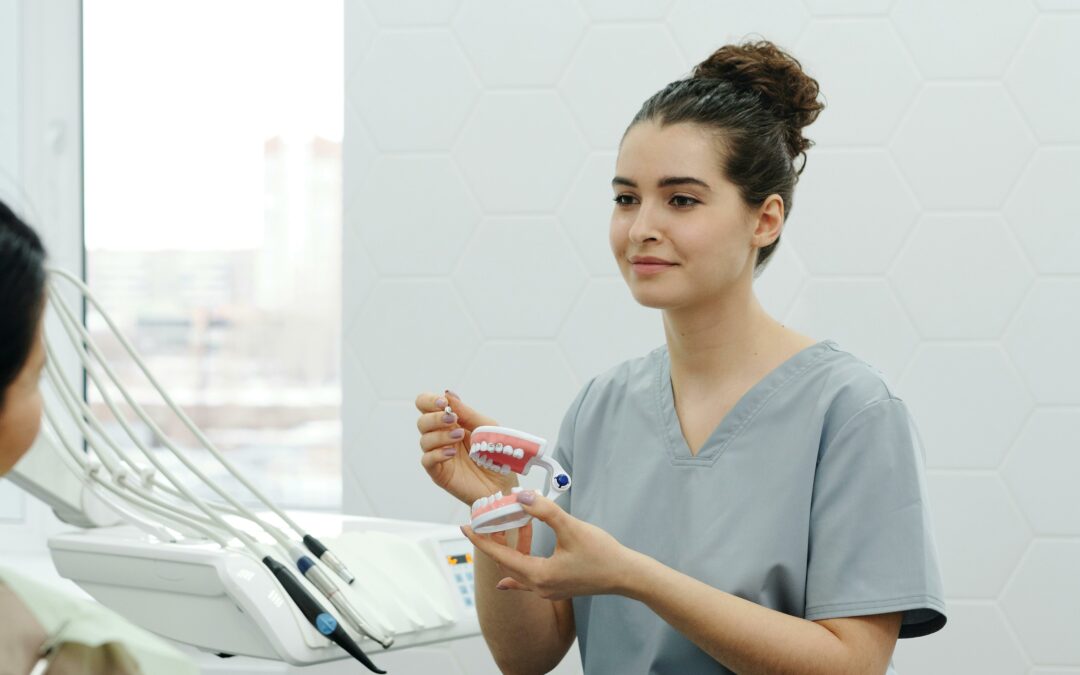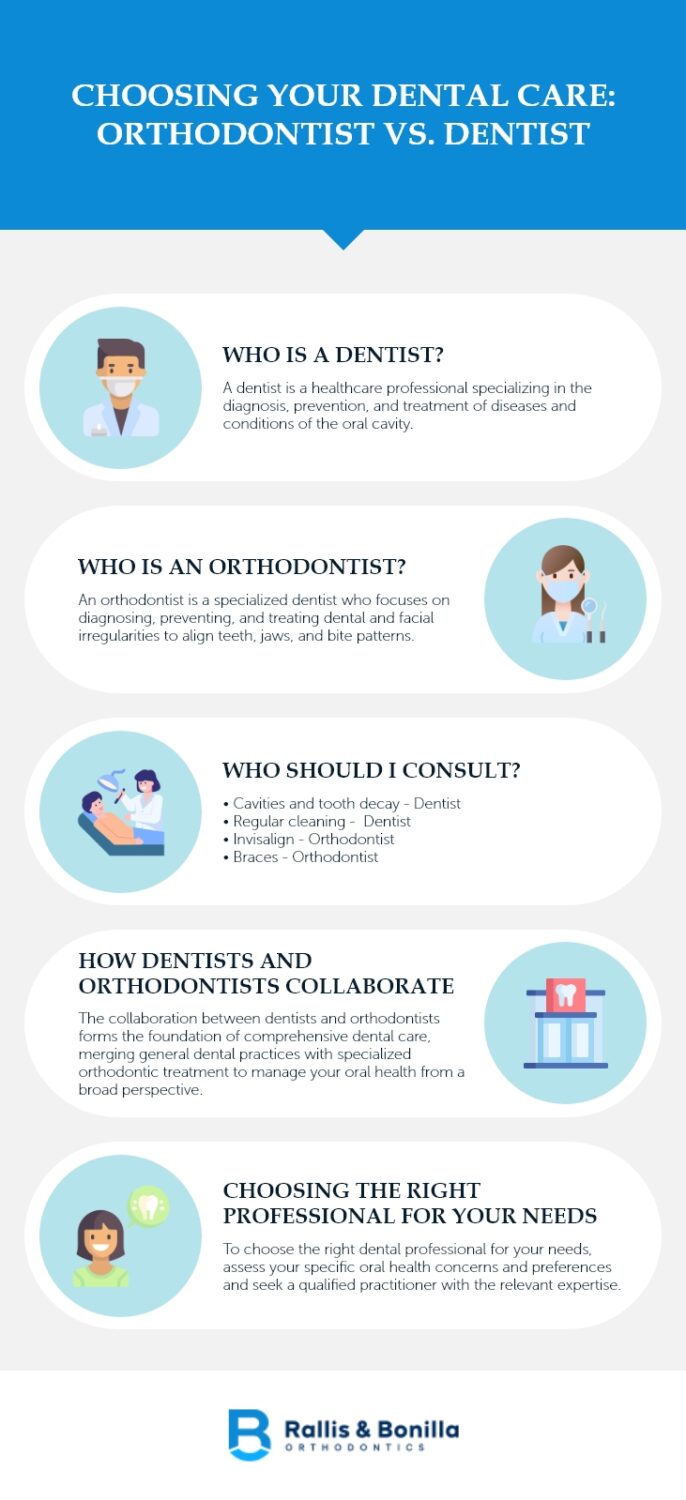When it comes to taking care of your teeth and gums, knowing who to turn to is key. In the world of oral care, you’ll come across two main types of dental professionals: dentists and orthodontists. Both are dedicated to helping you maintain a healthy smile, but they focus on different aspects of dental health. While both orthodontists and dentists are crucial members of our dental team, understanding what each professional does will help you make informed decisions about your oral health care.
In this blog post, we’ll look at what services orthodontists and dentists offer and what makes them uniquely skilled. By the end, you’ll know exactly when to see an orthodontist and when a dentist is a better alternative. Let’s dive in and make your path to a healthy smile as clear and positive as possible!
Who Is a Dentist?
A dentist is a healthcare professional specializing in the general care of teeth and gums, focusing on preventing, diagnosing, and treating oral health conditions. They are your primary care dental provider, skilled in a wide range of essential services for maintaining oral hygiene and health.
Here are some of the key dental services you can expect from your dentist:
- Routine Check-ups – Regular checkups with your dentist, usually every six months, allow for a thorough examination of your teeth and gums to catch any potential dental conditions early.
- Cleaning – Professional dental cleanings remove plaque and tartar that can’t be brushed away at home. This helps prevent cavities and gum disease.
- Fillings – When you have a cavity, a dentist removes the decayed part of the tooth and fills it with a durable material to restore its shape and function.
- Root Canals – If the pulp inside your tooth becomes infected, a root canal may be necessary to remove the infected tissue and save the tooth.
- Tooth Extraction – This involves removing a tooth from its socket in the gum. The most common reasons for tooth extraction are severe damage or tooth decay, overcrowding, and infection.
- Crowns and Bridges – Crowns are used to cover and protect damaged or weakened teeth, while bridges replace missing teeth by anchoring to adjacent teeth.
- Teeth Whitening – Professional whitening services can remove stains and brighten your smile more effectively and safely than over-the-counter products.
- Gum Disease Treatment – Regular dentists can treat milder forms of gum disease, such as gingivitis, through procedures like scaling and root planing and prescribe antibiotics.
- Dentures – For those missing several teeth or all of their teeth, dentures are removable appliances that can help restore the look and function of your smile.
- Emergency Dental Care – If you have a dental emergency, such as a severe toothache, broken tooth, or injury to your mouth, dentists can provide immediate care.
Dentists also play a crucial role in educating patients about oral health care, including the importance of brushing, flossing, and regular dental checkups to prevent dental problems. They can provide valuable advice on diet and lifestyle that can affect your oral health.
Your family dentist plays a crucial role in maintaining your oral health. They are your partners in your ongoing oral healthcare, working with you to keep your teeth and gums healthy throughout your life.
Who Is an Orthodontist?
An orthodontist is a dental specialist who focuses on diagnosing, preventing, and treating dental and facial growth irregularities. They are experts in managing the movement of teeth and guiding facial development to ensure both functional and aesthetic outcomes. Orthodontists have the specialized training to correct misaligned teeth and jaws, ensuring that you can bite, chew, and speak effectively and comfortably.
After completing the same educational path as dentists, including undergraduate studies and dental school, orthodontists undergo additional years of specialized training exclusively in orthodontic care. This advanced training equips them with the skills to use braces, Invisalign, and other teeth and jaw corrective devices.
Orthodontists work with patients of all ages, addressing various needs, from simple adjustments to complex corrections. Here are some of the specialized services provided by an orthodontist:
- Comprehensive Orthodontic Evaluation – Orthodontists begin with a thorough examination of your teeth, jaws, and facial structure. This evaluation often includes 3D scanning and imaging to understand the underlying bone structure and to develop a customized treatment plan.
- Braces – Traditional braces, made of metal or ceramic brackets connected by wires, are the most common treatment for correcting misalignment. They are effective for treating a wide range of issues, from simple gaps between teeth, crooked teeth, and crowded teeth to complex bite alignment.
- Invisalign – Invisalign is an effective alternative to traditional braces for many people. Rather than using brackets, wires, and elastics, Invisalign uses clear plastic aligners designed based on the needs of your dental anatomy.
- SureSmile – SureSmile braces are custom-fit, removable clear aligners that gradually straighten teeth. This orthodontic treatment involves the use of robotic technology to customize archwires, allowing for more precise and efficient tooth movement.
- Corrective Jaw Surgery – In cases where the teeth and jaw alignment issues are more severe, orthodontists work with oral surgeons to perform corrective jaw surgery. This oral surgery can improve the functionality and appearance of the jaw.
- Treatment of Malocclusions – Orthodontists specialize in treating dental malocclusions or improper bites, including overbite, underbite, crossbite, and open bite. Correcting these oral health issues can improve chewing, speaking, and dental health.
- Preventive and Interceptive Treatment – Orthodontic treatments have the potential to guide the development of teeth and jaw growth in younger patients, thereby potentially mitigating the necessity for future invasive interventions.
Orthodontists are committed to using their specialized skills to create a healthier, more beautiful smile. Their focus on personalized care ensures that each patient receives treatment tailored to their unique needs, with the goal of achieving the best possible outcomes. With modern advancements in orthodontic technology, they offer a range of treatment options designed to minimize discomfort and reduce the visibility of treatment, making your journey to a perfect smile both efficient and comfortable.
How Dentists and Orthodontists Collaborate
Dentists and orthodontists play unique and complementary roles in your oral health care, often working together to ensure you receive comprehensive care. Here’s how dentists and orthodontists team up to provide you with the best possible care.
- Initial Assessments and Referrals – Your journey typically starts with a visit to the dentist, who performs regular checkups and addresses general dental issues. If your dentist identifies a need for specialized alignment treatment during your consultation, they will refer you to an orthodontist. This partnership ensures that any potential tooth alignment issues are caught early and treated by a specialist with the right expertise.
- Creating a Comprehensive Treatment Plan – Once an orthodontist is brought into your care team, they work closely with your dentist to create a personalized treatment plan that addresses both your alignment needs and overall oral health. This involves coordinating treatments to resolve issues like cavities before beginning orthodontic treatment, ensuring a healthy foundation for any corrective work.
- Shared Expertise for Complex Cases – In cases where dental and orthodontic issues are complex and intertwined, dentists and orthodontists share their expertise to develop a strategy that addresses all aspects of the problem. For example, suppose orthodontic work is needed to prepare for dental implants. In that case, the orthodontist will focus on aligning the teeth properly while the dentist will take care of the implant procedure, ensuring a cohesive approach to your care.
- Post-Treatment Care and Maintenance – The collaborative effort continues even after the conclusion of orthodontic treatment. Your orthodontist will provide retainers to maintain the new position of your straight teeth, while your dentist will continue to monitor your oral health, ensuring that your teeth and gums remain healthy after the braces or aligners come off. This joint effort helps sustain the results of your orthodontic treatment and prevents future dental issues.
The collaboration between dentists and orthodontists is a cornerstone of comprehensive dental care. Their partnership ensures that your oral health is managed with a broad perspective, combining general dental care with specialized orthodontic treatment. This team approach not only enhances the quality of care but also supports a more seamless and effective treatment experience for you.
Choosing the Right Professional for Your Needs
Choosing the right dental professional for your needs is crucial to maintaining optimal oral health. Whether you need routine care or specialized treatment, understanding how to choose the appropriate expert can make all the difference.
Here’s how to ensure you find the right professional for your dental needs.
- Evaluate Your Dental Health Needs – Choosing the right dental care professional is essential for maintaining healthy teeth. A dentist is your primary care provider for everyday dental needs like checkups, cleanings, and fillings. However, if you’re concerned about the alignment of your teeth or jaw or if you’re considering braces, an orthodontist is the specialist you need.
- Consider Experience and Qualifications – When choosing a dental professional, look into their qualifications, including their education, training, and any certifications. For orthodontists, additional years of specialized training beyond dental school are crucial. Experience matters, as more experienced professionals will likely have handled a wide array of cases similar to yours.
- Ask for Recommendations – Word-of-mouth recommendations from family, friends, or your family dentist can be invaluable. People’s firsthand experiences with specific dental professionals can give you insights into what to expect in terms of care and treatment outcomes.
- Check Reviews and Testimonials – Online reviews and testimonials can also provide a glimpse into the quality of care provided by a dental professional. Look for feedback on their approachability, effectiveness of treatment, and overall patient satisfaction.
- Schedule an Initial Consultation – Most dental professionals are happy to offer consultations. This is a great opportunity to meet them, ask questions, and discuss your dental needs. It also allows you to get a feel for their practice and decide if they’re the right fit for you.
- Evaluate Their Approach and Communication – Choose a professional who takes the time to explain things clearly and address your concerns. Good communication is key to any successful dental treatment. You should feel comfortable and understood by your dental care provider.
- Consider Convenience – Finally, consider the location and office hours of the dental office. Accessibility and the ability to schedule appointments that fit your lifestyle are important factors in maintaining regular dental visits.
Remember, the goal is to find a dental professional who can provide the specific care you need in a comfortable, reassuring environment. Whether it’s a dentist for your general oral health needs or an orthodontist for alignment issues, the right professional will guide you toward achieving a healthy, confident smile.
Taking the first step towards a healthier, more beautiful smile is easier than you think. At Rallis & Bonilla Orthodontics, we’re committed to providing you with the highest quality care in a warm, welcoming environment at one of our convenient locations: North Star Office, 84th Street Office, or Yankee Hill Office. Whether you’re considering braces for yourself or your child or have questions about the alignment of your teeth and jaw, our team of experts is here to guide you every step of the way. With the most advanced orthodontic technology in Nebraska, we tailor treatment plans to the individual needs of patients of all ages in an effort to minimize treatment time and maximize comfort. Let us help you take that next step towards a confident, radiant smile.

